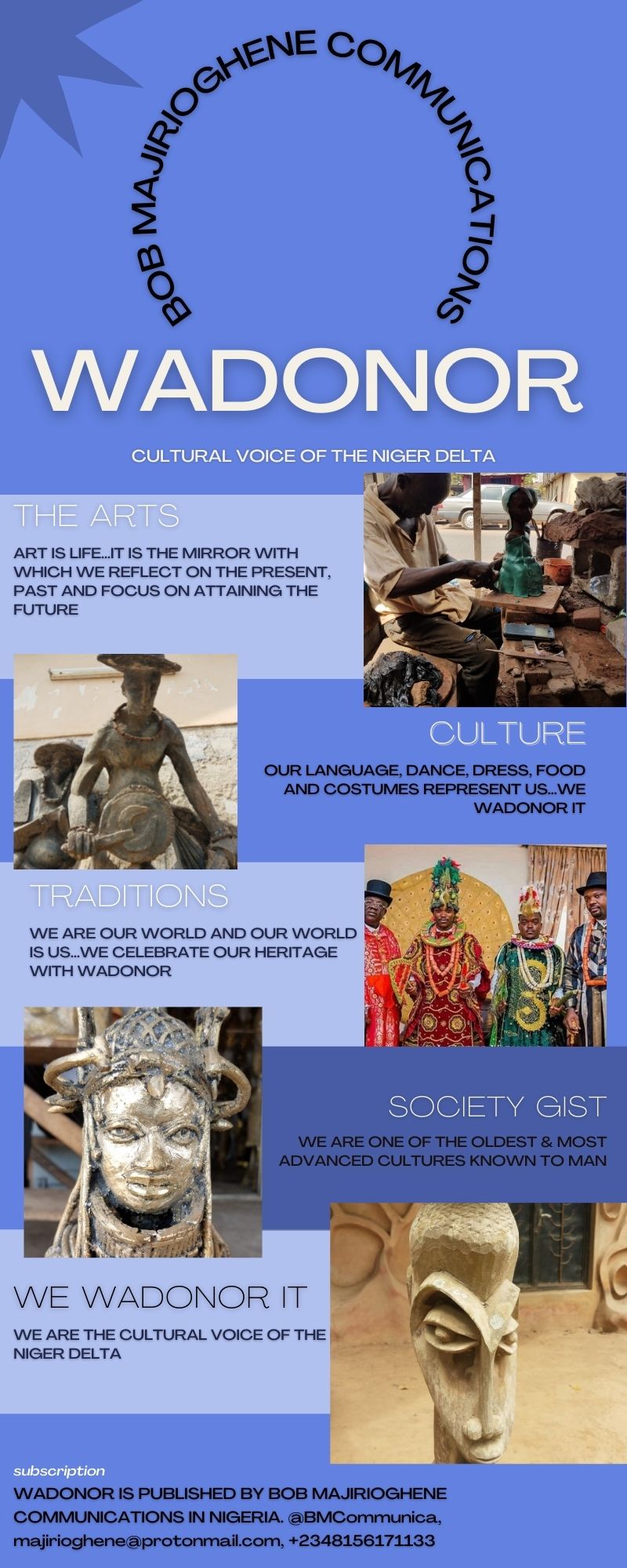
By
WADONOR, cultural Voice of Nigeria
Ikilo Osakpolor is 27 but already making his mark in the cultural sector. Apart from painting, he is currently writing books which he hopes to publish on Amazon in the near future. WADONOR ran into him at the Made in Nigeria Art Exhibition at the Victor Uwaifo Creative Hub in Benin City. 29th September – 1st October 2022. The Exhibition which was organized by the German Cooperation, was implemented by Deutsche Gesellschaft fur Internationale Zusammenarbeit, GIZ, the Nigerian-German Centre and the Nosona Studios.

As we observed Ikilo, we saw him peer at his work – the 18 x 7 Usi–Okuo, the Fame of War, hanging among the several paintings and sculpted pieces at the Exhibition. Every once in a while, he would glance at the teeming audience which had showed up at the Made in Nigeria exhibition, and peer back at his work.
We found out this was his first exhibition. So we followed his gaze. Looking at the 18 x 7 Ikilo piece, the Usi–Okuo, your first impression is that this is one of those Emotan art works for which Benin City Edo state is famous, but no. Osakpolor’s piece eloquently describes an aspect of the war that the Benin Kingdom had with the British in 1897. Instead of the regular appurtenances that make up the traditional Emotan mask, Ikilo instead chose to reflect the antecedents and scars that the 1897 war with the British exacted on Benin Kingdom. Just by the chin of the mask, you see a gun and an Eben (Benin Sword), symbols of the weapons used during the war. Instead of what was to be a crown, the sculptor used gnarled bodies of British and Bini soldiers. Next to those bodies is a figure which looks like a book, which Ikilo says is the document that records that war. At the centre of the mask, two holes indicate bullet holes fired directly at the forehead of the Benin Kingdom, and with caked blood on the mask just above the left eye of the mask.

But Ikilo was not the only artist at the Made in Nigeria Exhibition that beautiful evening. There were other budding artists like Osas Ajiri Destiny, Ejimuda Darlington, Okundia Queen, Olufunmilayo Aderemi, Oyibode Destiny, Moses Greg Esheshare, Omolosho Olawunmi, Enidunni Boluwatife, Ewulo Oluwafunmilayo, Henry Alohamn, Izekor Osasogie, James Eze, Faluyi Femi, Faith Ejuaye, Benson, Chibuzor, Favour Uwaifo, Egbon Osasumwen, Nwanfo Promise, Chioma Oko, Akwemoh Solomon, Ebeyin Joseph, Nnanyelugo Damian, Ettah Bassey, George Ogievayevbona, Uguagbe Desmond, Odia Destiny, Ugodo Junior, Joshua Shammah and Aliya. These were the young Nigerian sculptors and painters who passed through a Nigeria Art Masterclass by the GIZ.
Like Ikilo’s, one look at Ajiri Destiny’s piece, Goddess Ivie, you come off with the impression that the massive painting behind her is a celebration of the Olokun, the water deity of the Bini. It is a figure of a woman all red cresting on the waves of the sea. But no, according to Ajiri. Hear her: ‘The painting I created is influenced by one of the most cultural importance of the Benin people: coral beads. The Benin people are famous for their red coral beads which are worn by the royal family and brides, at cultural festivities. The coral beads trace back to ancient Benin and are extremely important to the tribe, attire, lifestyle culture and heritage. These coral beads represent power, dominance and hierarchy’.

Sandra Vermuijten, team leader of the GIZ Migration for Development, PME, said that the initiative was to contribute to the growing contemporary art sector in Nigeria. ‘we aim to support young Nigerian artists with training and support and participation at exhibitions. The themes of the artworks relate to work and life, and issues of migration and return.
Enotie Ogbebor, creative director of Nosona studios/Edo global art foundation said that ‘the journey continues and we value the feedback from the artists and the general public as we prepare to exhibit the works created during the 5-day workshop.
Common mediums used by the artists included acrylic/newspaper/charcoal on canvas, oil on canvas, acrylic on ink canvas, fabric and carton, fibre glass and mild steel, metal cast, wood and scrap metal.
